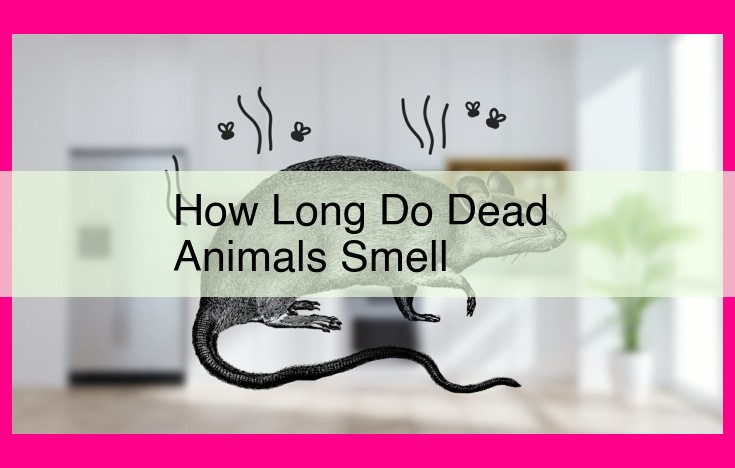Understanding Dead Animal Odor Decomposition And Odor Control Techniques

The duration of odor from dead animals depends on factors such as the decomposition process (autolysis, putrefaction, amonification, mineralization), insects involved, body size, temperature, and environmental conditions. Volatile organic compounds (VOCs) like cadaverine and putrescine contribute to the odor intensity, which can be influenced by olfactory receptors and odor thresholds. Odor control techniques include air purifiers, ozone generators, and odor absorbents to neutralize and remove odors from the environment.
Understanding the Decomposition Process: Unraveling the Odorous Journey
When an organism passes away, its remains embark on a remarkable transformation known as decomposition. This intricate process involves four distinct stages, each characterized by unique chemical changes and the release of characteristic odors.
Stage 1: Autolysis
Immediately after death, the organism’s cellular machinery kicks into action, breaking down its own tissues. This stage lasts for several hours to a few days, during which enzymes released from damaged cells digest internal organs and soft tissues. As cell walls break down, a sour odor is produced.
Stage 2: Putrefaction
As bacteria and other microscopic organisms invade the decaying matter, a more intense phase known as putrefaction begins. These microbes feast on the remains, consuming proteins and producing volatile organic compounds (VOCs). Cadaverine, putrescine, indole, and scatole are among the notorious VOCs released during putrefaction, giving off a distinctive, pungent odor.
Stage 3: Ammoniation
As the putrefaction process continues, ammonia is produced in abundance. This gas is a byproduct of bacterial decomposition and contributes a sharp, pungent smell.
Stage 4: Mineralization
The final stage of decomposition involves the formation of stable inorganic compounds. The remains gradually lose their organic matter, leaving behind only a skeleton or other mineral components. This stage is characterized by a faint earthy odor, as the remaining minerals interact with the surrounding environment.
Factors Influencing the Intensity of Odor from Decomposing Dead Animals
When a living creature dies, their body begins a natural process of decomposition. This process involves the breakdown of organic matter by various organisms, primarily bacteria and insects. As a result, the body releases various volatile organic compounds (VOCs) that produce unpleasant odors. Several factors influence the intensity of these odors, including:
1. Decomposing Carcasses
The size, species, and condition of the carcass can significantly affect odor intensity. Larger carcasses release more VOCs, resulting in stronger odors. Animals with higher fat content also produce more intense odors due to the presence of additional lipids that decompose. The freshness of the carcass also plays a role, with fresher carcasses producing milder odors than older ones.
2. Insects Involved in Decomposition
Insects play a crucial role in the decomposition process and can influence odor intensity. Different insects produce different VOCs, which contribute to the overall odor profile. For example, flies produce cadaverine and putrescine, while beetles release indole and scatole. The abundance and diversity of insects involved in decomposition can significantly impact odor intensity.
3. Olfactory Receptors and Odor Thresholds
Human olfactory receptors detect and interpret VOCs, triggering our perception of odors. Odor thresholds vary widely among individuals, with some people being more sensitive to certain odors than others. Therefore, the intensity of odor experienced from decomposing carcasses can vary based on individual sensitivity.
4. Environmental Conditions
Temperature plays a significant role in odor intensity. Warmer temperatures accelerate the decomposition process, leading to increased VOC production and stronger odors. Exposure to elements such as rain and sunlight can also affect odor intensity. Body size, decomposition time, and specific environmental conditions (e.g., humidity, pH) can further influence odor intensity.
Odor Control Techniques for Dead Animal Removal
Unpleasant odors often accompany the unfortunate task of removing dead animals. These odors are not only bothersome but can also pose health risks. Fortunately, several effective methods can help control and eliminate these pungent smells.
Air Purifiers: Removing Odor at the Source
Air purifiers are designed to remove various pollutants and odors from the air. Look for models equipped with HEPA filters, which can effectively trap odor-causing particles. Place the air purifier in the affected area and allow it to circulate and cleanse the air.
Ozone Generators: Oxidizing and Neutralizing Odors
Ozone generators produce ozone, a powerful oxidizing agent that can break down odor molecules. Ozone can be particularly effective in neutralizing the strong, unpleasant odors associated with dead animal decomposition. However, it is important to note that ozone is toxic at high levels, so follow the manufacturer’s instructions carefully when using an ozone generator.
Odor Absorbents: Trapping and Neutralizing Odors
Odor absorbents are materials that trap and neutralize odors. Activated charcoal, baking soda, and silica gel are common odor absorbers that can be placed in the affected area. These absorbents work by binding to odor molecules, effectively reducing the intensity of the smell.